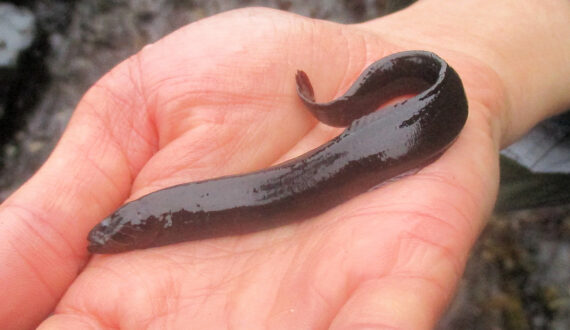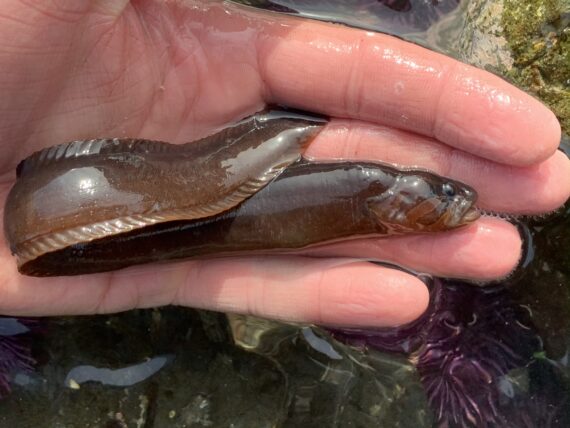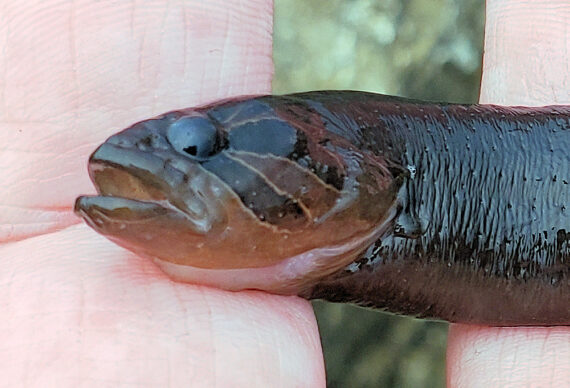Black Prickleback, Xiphister atropurpureus
 Black Prickleback, Xiphister atropurpureus. Fish caught from a tidal pool in Ucluelet, British Columbia, August 2021. Length: 14 cm (5.5 inches). Catch, photograph and identification courtesy of of George Brinkman, Guelph, Ontario, Canada.
Black Prickleback, Xiphister atropurpureus. Fish caught from a tidal pool in Ucluelet, British Columbia, August 2021. Length: 14 cm (5.5 inches). Catch, photograph and identification courtesy of of George Brinkman, Guelph, Ontario, Canada.
 Black Prickleback, Xiphister atropurpureus. Fish caught from a tidal pool in Brookings, Oregon, August 2021. Length: 18 cm (7.1 inches). Catch, photograph and identification courtesy of Luke Ovgard, Klamath Falls, Oregon.
Black Prickleback, Xiphister atropurpureus. Fish caught from a tidal pool in Brookings, Oregon, August 2021. Length: 18 cm (7.1 inches). Catch, photograph and identification courtesy of Luke Ovgard, Klamath Falls, Oregon.

 Black Prickleback, Xiphister atropurpureus. Fish caught from a tidal pool in coastal waters of Monterey, California, April 2021. Length: 12 cm (4.7 inches). Catch, photograph and identification courtesy of Chris Moore, Peoria, Arizona.
Black Prickleback, Xiphister atropurpureus. Fish caught from a tidal pool in coastal waters of Monterey, California, April 2021. Length: 12 cm (4.7 inches). Catch, photograph and identification courtesy of Chris Moore, Peoria, Arizona.
 Black Prickleback, Xiphister atropurpureus. Fish caught from coastal waters off Half Moon Bay, California, July 2012. Length: 28 cm (11 inches). Catch, photograph and identification courtesy of Eli (obsessiveangling.wordpress.com).
Black Prickleback, Xiphister atropurpureus. Fish caught from coastal waters off Half Moon Bay, California, July 2012. Length: 28 cm (11 inches). Catch, photograph and identification courtesy of Eli (obsessiveangling.wordpress.com).
The Black Prickleback, Xiphister atropurpureus, is a member of the Prickleback or Stichaeidae Family, that is known in Mexico as abrojo negro. Globally, the Stichaeidae Family has seventy-one known species that have been placed into thirty-five genera with two global species in the genus Xiphister, with this species being the only one found in Mexican waters of the Pacific Ocean and is described here.
The Black Prickleback has an elongated eel-like body that maintains its depth almost to the wide caudal fin. They are a dark reddish brown to black color with the head having three dark light-edged bands radiating from the eyes. Some fish have a prominent light band across the base of the caudal in that extends onto the anal and dorsal fins. Their head has a bluntly rounded short snout with large eyes set on top. Their anal fin has 1 spine and 40 to 52 rays; their caudal fin is rounded with minute flaps; their dorsal fin has 65 to 73 spines and originates half way between snout tip and the anal fin origin; their pectoral fins are minute; and they do not have pelvic fins. They have 8 to 12 gill rakers.
The Black Prickleback is an inshore non-migratory species found demersal in tidal pools, shallow rocky and gravel areas from the intertidal zone to depths up to 27 m (90 feet). They reach a maximum of 32 cm (13 inches) in length. They have the somewhat unique characteristic of being able to remain out of water for up to 24 hours under rocks or within seaweed due to their ability to breathe air. They consume green and red algae, crustaceans polychaetes, snails and surfgrass. In turn they are preyed upon by numerous fish, sea mammals and snakes. Reproduction is oviparous with each female producing between 500 and 8,000 eggs that are laid in several clumps or masses which are then guarded by the males. They have life spans of up to fifteen years. The Black Prickleback is poorly studied with very limited information available about their lifestyle and behavioral patterns including specific details on age, growth, longevity, movement patterns, diet, habitat use, and reproduction.
The Black Prickleback is a resident of Mexican waters of the Pacific Ocean but has a limited distribution being found from Isla San Martín, Baja California, northward along the northwest coast of Baja. They are caught from shore by recreational anglers occasionally.
The Black Prickleback is a straightforward identification it being the only member of its genus found in Mexican waters of the Pacific. If confused it is most likely with the Monkeyface Prickleback, Cebidichthys violaceus (prominent lateral line, humps on the forehead).
From a conservation perspective the Black Prickleback has not yet been formally evaluated. They are relatively small in stature and of limited interest to most.